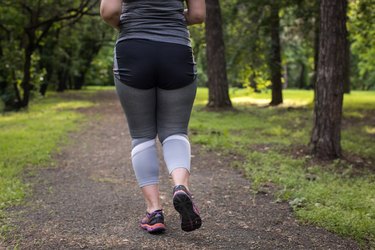
The term "saddle bags" is a not-so-nice way to describe the accumulation of fat around the hips and thighs. It's an undesired yet common feature of the female form, especially for those who tend to carry weight in their lower body. Luckily, regular cardiovascular exercise can help reduce the appearance of saddle bags, when combined with a calorie-controlled diet. How much cardio you should do depends on your daily activity level, your calorie intake and the intensity of your workouts.
Weight Loss 101
Video of the Day
People refer to weight loss, but the real goal is fat loss. Your body burns fat when you take in fewer calories than you expend each day. This is often referred to as being in a caloric deficit. The purpose of cardio exercise when it comes to losing fat is to help you create that deficit. But cardio can't make up for a bad diet that is too high in calories. You have to combine regular cardio exercise with a calorie-controlled diet to see results.
Video of the Day
Read more: The Forgotten Keys to Fat Loss
Fat Loss Timeline
How quickly you'll reduce your saddle bags depends on numerous factors. Genetics is one of them and makes it very hard to determine how quickly you can shed fat. If you have an active job, you'll burn more calories each day and lose your saddle bags more quickly than someone with a desk job.
A rough estimate is that 3,500 calories is equivalent to 1 pound of body fat, according to the Centers for Disease Control and Prevention. By reducing your daily caloric intake and exercising, you can create a calorie deficit of 500 calories per day, which would mean a pound of fat loss each week. Create a deficit of 1,000 calories per day and you'll lose roughly 2 pounds per week. Losing any more than 2 pounds per week isn't safe or sustainable.
The main thing to keep in mind is that you can't target one specific area of your body for fat loss. Although you may be very eager to shed your saddle bags, you have to lose total-body fat. You may lose fat in other places first, but you will eventually see a reduction in fat around your hips and thighs.
Calories Burned
The general rule of thumb is that the more intense your workout, the more calories you'll burn. Some cardio exercises are more effective at burning calories than others. For instance, a 130 pound person can burn 195 calories per hour walking at a moderate pace, 413 calories per hour pedaling at a moderate pace on a stationary bike, and 472 calories per hour running at a pace of 5 mph. That same person can burn 224 calories per hour walking at a brisk pace, 620 calories pedaling vigorously on a stationary bike, and 590 calories running at a pace of 6 mph.
Duration
How long your workout sessions should be depends on how many calories you need to burn to create your target calorie deficit. It also depends on how intensely you work out. The CDC recommends at least 150 minutes of moderate-intensity activity or 75 minutes of vigorous activity each week. Increasing that amount to 300 minutes of moderate-intensity activity or 150 minutes of vigorous activity each week can increase the health and fat loss benefits.
Read more: How to Use the Elliptical for Fat Loss